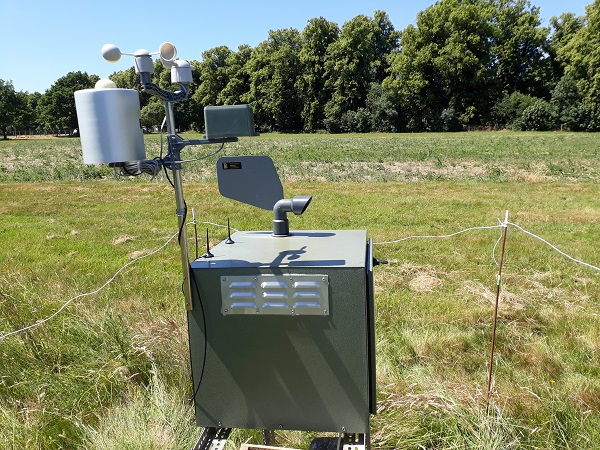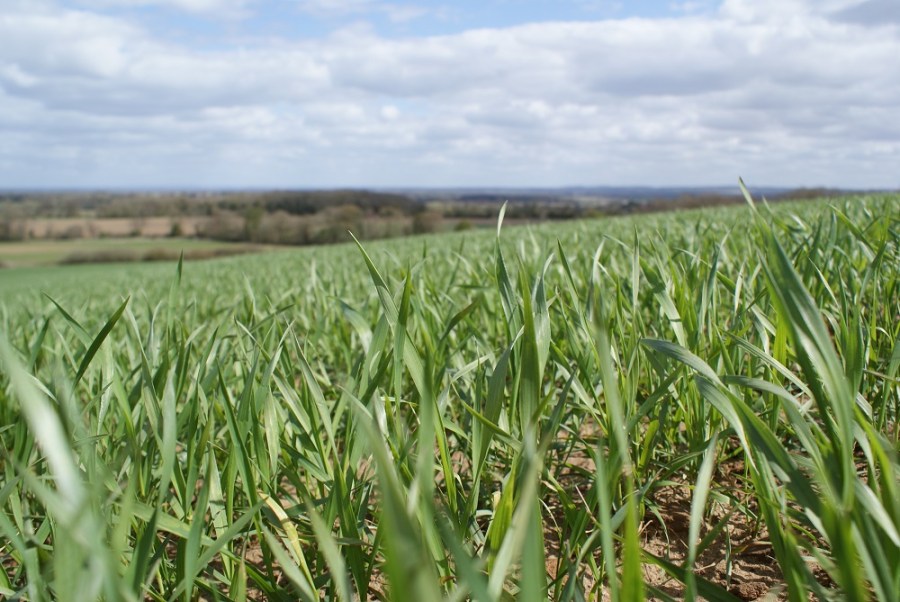Fungicide applications are very much an insurance measure, with resistance a growing problem. CPM finds out how spore-trapping may help growers refine their fungicide programmes using real-time information on disease pressure and its likely development.
The technology will enable growers to apply fungicides more precisely.
By Lucy de la Pasture
It’s a sure sign that when an innovation is being worked on simultaneously by different groups of pioneers it’s likely to be a game-changer. It happened with the light bulb, the telephone and the aeroplane, and right now it’s happening in agriculture.
Scientists at both Rothamsted Research and Fera have independently developed systems to monitor the levels of disease spores in the air. These spore traps work automatically, drawing in a sample of air, preparing it for testing and running a DNA test to identify and quantify the disease spores present.
Both research institutions have also built disease models which use weather data to help interpret the spore trapping information and predict the risk of disease developing in crops. It’s an important technology that will provide decision support services (DSS) to help growers better manage diseases and the fungicides that are used to control them, explains AHDB’s Cathryn Lambourne.

The spore trap being developed at Rothamsted sucks air in during the day and runs its diagnostic tests at night, sending the results by text message.
“DSSs are a necessity for IPM approaches, which are key to managing crops with a reducing number of active ingredients. But it’s not just about fungicide loss, they will help reduce fungicide use by providing disease-risk information in near real-time.” she says.
AHDB have involvement with both projects, co-funding the research at Rothamsted in partnership with the device manufacturer. AHDB are also partners in CHAP, the agritech centre responsible for Crop Health And Protection. The CHAP work is being carried out in partnership with Fera, with funding support from Innovate-UK.
Rothamsted’s Professor Jon West describes the novel spore-trapping devices as a new type of precision agriculture. “The technology will enable growers to apply fungicides more precisely, particularly when diseases are difficult to control or sporadic in occurrence,” he says.
The information the Rothamsted DSS will provide will also help growers with management decisions outside of the normal timings, he explains. “Fungicide applications at T1 and T2 are made to protect the top three leaves of the cereal plant which are the biggest contributors to yield. But where the device may prove helpful is in identifying whether crops may need an earlier spray for yellow rust or a late spray for the wind-dispersed spores of septoria, which can infect the flag leaf late-on in the season when earlier-applied fungicide sprays may have degraded.”
The spore trapping device has been designed by Burkard Manufacturing. It’s mains-powered, enabling a powerful cyclone to suck in 300 litres of air/min, which is about 30 times more than the capacity of its predecessors, explains Jon.
“Air is sucked in during the day and the device runs its diagnostic tests at night. To do this the spores are broken open to release their DNA and a liquid reagent is added.”
The spore traps employ loop-mediated isothermal amplification (LAMP) which uses assays developed for specific diseases, which are the really clever bit of technology ‘under the bonnet’ that required extensive research to develop. It’s now even possible to identify azole and SDHI insensitivity in the DNA of airborne spores, he adds.
The assays contain carefully designed primers that bind to the target DNA, replicating it many times so that the amount of DNA in the reaction increases greatly. This all takes place at a constant temperature, with each device able to test using three different disease assays at any one time. The DNA is quantified by its degree of fluorescence when a light is directed at the reaction tube, which is every five seconds in the device, explains Jon.
“Having made its diagnosis, the spore-trapping device communicates its findings by text message, providing the grower with information to assist spray or no-spray decisions which can be combined with weather data to further refine the likelihood of the disease developing, providing a forecast of risk.”
Within the AHDB project, a lot of work has been carried out to find the best siting for the spore-trap. “We looked at different mounting levels to see how it affected the number and type of spores being detected. We found that when mounted on a rooftop at about 10m, we trapped twice the number of species of spores than when the device was mounted on the ground.
“When the device is raised the air is more mixed-up, so spores are blown in from different sources. At ground level the air is partially filtered by surrounding vegetation and crops,” he explains.
As a result of the work Jon suggests the optimum position for the trap will be mounted on a building, which will give the added benefit of improved security, but the device needs to remain easily accessible for the weekly job of changing the reagent cartridge that enables the diagnostics.
The Fera Spore Sentry has been developed along very similar lines and is using the existing Crop Monitor as its core platform. The spore trapping network integrates with a bespoke weather monitoring network, national pest and disease surveillance data and advanced risk models to produce a risk forecasts for pests and diseases of wheat, barley, oilseed rape and potatoes.
The service will enable farmers and growers to make informed decisions based on a wealth of information that could lead to reduced costs and increased yields, explains Fera principal plant pathologist, Dr Judith Turner.
Currently in its pilot phase, the Fera project is building up data across its 30 sites before the service becomes subscription-based in March 2019. “Crop Monitor is a generic platform and designed to host this type of in-field detection system. Information from the Fera SMART DSS has been available on Crop Monitor this season and provides a traffic light system for disease risk across the UK,” she explains.
This real-time data will provide information that can be used to inform decisions on when and where to spray on a preventative basis, says Judith. “The SMART DSS will also have access to the latest data on fungicide resistance, via an interactive search facility. It will provide farmers comprehensive information to enable them to make decisions that avoid the overuse of pesticides and are appropriate to current risk levels.”
Disease-risk information for potatoes is the most recent addition to Crop Monitor this spring. Fera is working on plans to integrate the AHDB’s blight monitoring programme, Fight Against Blight, which a service being run by CHAP this season, which is collecting negative findings on blight.
“It’s as important to have information on where no blight symptoms are being seen in crops as it is to know where blight outbreaks have occurred. These negative findings help us test and validate the new models for blight forecasting but do rely on the participation of agronomists and growers.
“Although the models are robust, they don’t work in complete isolation so it’s important to keep feeding real-life information back to us, so they can continue to improve in accuracy,” she points out.
In-field diagnostics in field vegetables has also moved on with the introduction of lateral-flow devices (like pregnancy tests) which use an immune-assay to provide a positive or negative for the presence of a pathogen, says Cathryn.
“The test picks up the presence of spores carried in the air around crops in the field. Used alongside weather data, test results could indicate how likely a disease is to develop, allowing growers to decide if crop protection methods are needed or not.
“Currently a LFD is available for ring spot and light leaf spot in brassicas and is being developed for downy mildew in onions. It’s a step in the right direction before a DNA-based system of monitoring becomes available for use in vegetable crops,” she comments.
Spore traps join the ultimate experiment in automation
Agronomy is touchy-feely by nature. It involves walking through the crop, pushing back the canopy to see what’s going on in the bottom of the crop, inspecting the leaves, pulling up the odd plant to look at its roots and dissecting it to establish its growth stage.
For Hutchinsons’ agronomist Kieran Walsh, all of these tools were lost to him when he took on the agronomy for the Hands Free Hectare (HFH) at Harper Adams University in Shrops. The project is the result if an idea born in a moment, he explains, made possible because the right people came together at the right time. Now in its second season and backed by AHDB funding, the HFH is attracting attention worldwide and stretching the boundaries of what’s possible without feet on the ground.
With much of the early work concentrating on the mechatronics that make the project possible, this season there’s been more time to focus on how to meet the needs of the crop without walking it.
“It’s been easier this year because we have the bits of kit that had to be designed as we went along last season. Although I can use rovers to scout the crop and soil sample, no robot can yet dissect a plant. So when I needed to establish the growth stage of the crop, we commissioned the rover to dig up a plant and bring it out of the hectare and back to mission control for me to look at,” explains Kieran.
“When I wanted to take leaf samples for tissue and disease analysis, we had to design a claw that fits underneath the big drone so that it can fly in and grab a sample. We’re also able to use the claw to collect ears so we can test the moisture content of the grain before harvest.”
This year the hectare is planted in wheat and Kieran says it’s been much easier having the tools in-hand. He’s been able to focus more on getting to know the field and its soil, sending the drone out more often than in its first season.
“We’ve used live-streaming from the drone and I’ve been able to visually inspect the crop from my office in the Cotswolds. From this aerial view, it’s been possible to identify areas of the crop I’m not happy with and then the drone has gone to have a closer look, flying just above the crop so I can zoom in on the problem area,” he explains.
This season Kieran has also had information from a spore trap which he’s found invaluable. “It’s really given an extra edge because disease and pest levels are the two most difficult things to monitor effectively with a drone. With the spore trap data and information from a weather station, we’ve known when there have been peaks in septoria infection and have been able to adjust rates and timings accordingly.
“Thanks to Bayer, we’ve also taken leaf tissues to be tested at Fera for latent septoria infection and when the results come back we’ll be able to see if we made the right spray decisions,” he adds.
Will this new technology replace the agronomist? Kieran emphatically believes that won’t happen, but it will provide a useful management tool, freeing up time currently spent scouting and driving from field to field. He also believes that spore-trapping will enable growers to manage out-lying land more reliably, giving them more freedom to choose varieties with the greatest margin potential.
Research Roundup
AHDB Project No 21120002-2140021 – ‘Arable Crop Disease Alert System’ ran from April 2015 to March 2018 at a cost of £75,000 (total cost £120,000).
AHDB Project No FV 456 – ‘Delivery of a Diagnostic test pilot scheme for Brassicas and Onions’ runs from July 2017 to May 2019 at a cost of £21,273 (total cost £38,173).
CHAP disease monitoring info is available at http://www.cropmonitor.co.uk/




